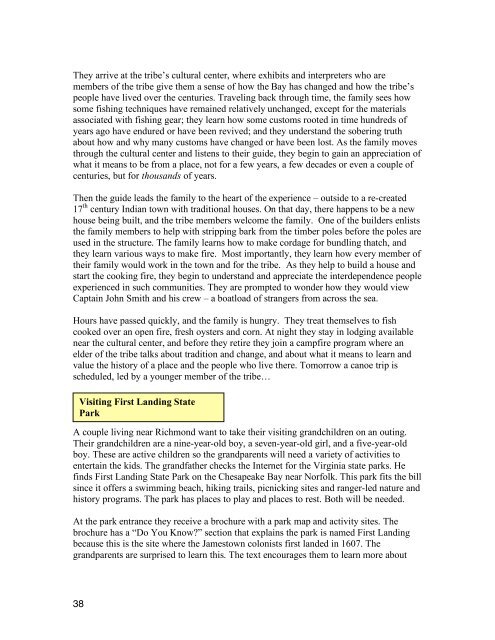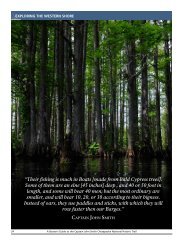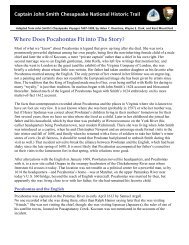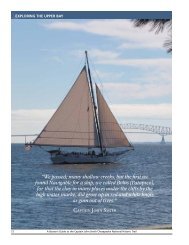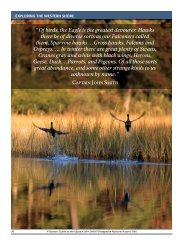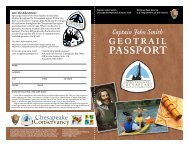Draft Interpretive Plan Join the adventure! - Captain John Smith ...
Draft Interpretive Plan Join the adventure! - Captain John Smith ...
Draft Interpretive Plan Join the adventure! - Captain John Smith ...
You also want an ePaper? Increase the reach of your titles
YUMPU automatically turns print PDFs into web optimized ePapers that Google loves.
They arrive at <strong>the</strong> tribe’s cultural center, where exhibits and interpreters who are<br />
members of <strong>the</strong> tribe give <strong>the</strong>m a sense of how <strong>the</strong> Bay has changed and how <strong>the</strong> tribe’s<br />
people have lived over <strong>the</strong> centuries. Traveling back through time, <strong>the</strong> family sees how<br />
some fishing techniques have remained relatively unchanged, except for <strong>the</strong> materials<br />
associated with fishing gear; <strong>the</strong>y learn how some customs rooted in time hundreds of<br />
years ago have endured or have been revived; and <strong>the</strong>y understand <strong>the</strong> sobering truth<br />
about how and why many customs have changed or have been lost. As <strong>the</strong> family moves<br />
through <strong>the</strong> cultural center and listens to <strong>the</strong>ir guide, <strong>the</strong>y begin to gain an appreciation of<br />
what it means to be from a place, not for a few years, a few decades or even a couple of<br />
centuries, but for thousands of years.<br />
Then <strong>the</strong> guide leads <strong>the</strong> family to <strong>the</strong> heart of <strong>the</strong> experience – outside to a re-created<br />
17 th century Indian town with traditional houses. On that day, <strong>the</strong>re happens to be a new<br />
house being built, and <strong>the</strong> tribe members welcome <strong>the</strong> family. One of <strong>the</strong> builders enlists<br />
<strong>the</strong> family members to help with stripping bark from <strong>the</strong> timber poles before <strong>the</strong> poles are<br />
used in <strong>the</strong> structure. The family learns how to make cordage for bundling thatch, and<br />
<strong>the</strong>y learn various ways to make fire. Most importantly, <strong>the</strong>y learn how every member of<br />
<strong>the</strong>ir family would work in <strong>the</strong> town and for <strong>the</strong> tribe. As <strong>the</strong>y help to build a house and<br />
start <strong>the</strong> cooking fire, <strong>the</strong>y begin to understand and appreciate <strong>the</strong> interdependence people<br />
experienced in such communities. They are prompted to wonder how <strong>the</strong>y would view<br />
<strong>Captain</strong> <strong>John</strong> <strong>Smith</strong> and his crew – a boatload of strangers from across <strong>the</strong> sea.<br />
Hours have passed quickly, and <strong>the</strong> family is hungry. They treat <strong>the</strong>mselves to fish<br />
cooked over an open fire, fresh oysters and corn. At night <strong>the</strong>y stay in lodging available<br />
near <strong>the</strong> cultural center, and before <strong>the</strong>y retire <strong>the</strong>y join a campfire program where an<br />
elder of <strong>the</strong> tribe talks about tradition and change, and about what it means to learn and<br />
value <strong>the</strong> history of a place and <strong>the</strong> people who live <strong>the</strong>re. Tomorrow a canoe trip is<br />
scheduled, led by a younger member of <strong>the</strong> tribe…<br />
Visiting First Landing State<br />
Park<br />
A couple living near Richmond want to take <strong>the</strong>ir visiting grandchildren on an outing.<br />
Their grandchildren are a nine-year-old boy, a seven-year-old girl, and a five-year-old<br />
boy. These are active children so <strong>the</strong> grandparents will need a variety of activities to<br />
entertain <strong>the</strong> kids. The grandfa<strong>the</strong>r checks <strong>the</strong> Internet for <strong>the</strong> Virginia state parks. He<br />
finds First Landing State Park on <strong>the</strong> Chesapeake Bay near Norfolk. This park fits <strong>the</strong> bill<br />
since it offers a swimming beach, hiking trails, picnicking sites and ranger-led nature and<br />
history programs. The park has places to play and places to rest. Both will be needed.<br />
At <strong>the</strong> park entrance <strong>the</strong>y receive a brochure with a park map and activity sites. The<br />
brochure has a “Do You Know?” section that explains <strong>the</strong> park is named First Landing<br />
because this is <strong>the</strong> site where <strong>the</strong> Jamestown colonists first landed in 1607. The<br />
grandparents are surprised to learn this. The text encourages <strong>the</strong>m to learn more about<br />
38


